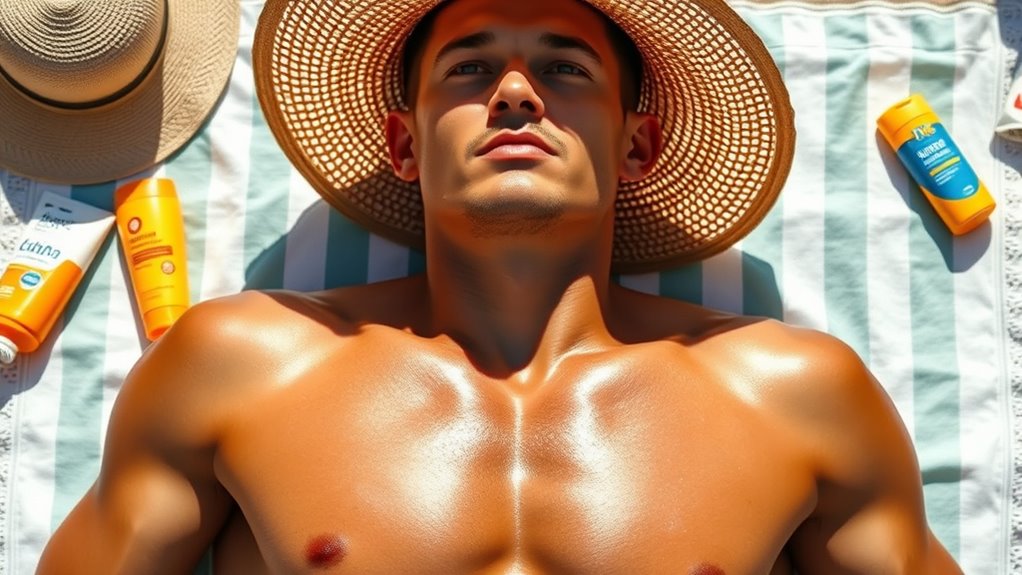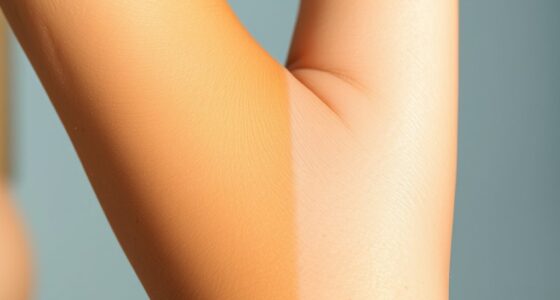Don’t fall for myths that indoor tanning is a safe way to get vitamin D or that a base tan protects your skin. Tanning beds mainly emit UVA rays, which can damage DNA and increase skin cancer risk—similar to natural sun exposure. Spray tans are a safer, quick alternative that don’t involve UV damage. If you’re curious about how to achieve a healthy glow without risking your skin, there’s more to discover.
Key Takeaways
- Indoor tanning beds mainly emit UVA rays, which don’t significantly boost vitamin D levels.
- Tanning beds can emit UV radiation stronger than natural sunlight, increasing skin cancer risk.
- A base tan offers minimal protection and doesn’t prevent sunburn or damage.
- Spray tans provide a safe, customizable, and quick alternative with no UV exposure.
- Relying on tanning for health or appearance is risky; natural sunlight, diet, and supplements are safer options.
Indoor Tanning Is an Essential Vitamin D Source
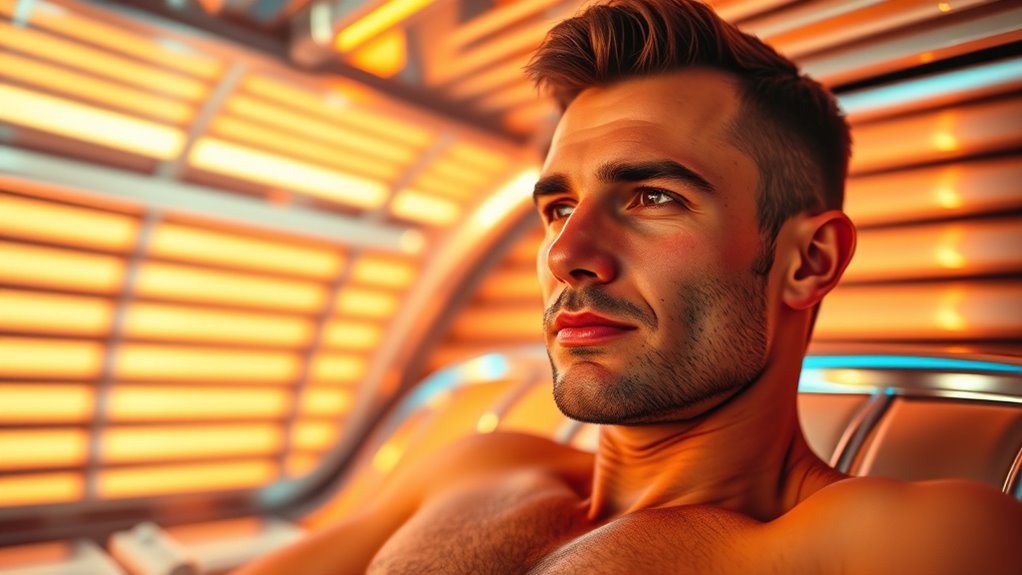
Many people believe that indoor tanning is a reliable way to get enough vitamin D, but that’s often not the case. Most tanning beds mainly emit UVA rays, which don’t substantially stimulate vitamin D production. Only beds with UVB-emitting bulbs can help increase your vitamin D levels. The effectiveness depends on the specific lamps and how long you expose yourself. Studies show that UVB sunbeds can boost serum vitamin D by 75–100% over weeks of use, sometimes raising levels above 100 nmol/L, which is enough for health. Additionally, creativity can be cultivated by anyone, regardless of skill level, emphasizing that safe and effective vitamin D sources are essential for overall well-being. However, not all tanning beds emit UVB, and excessive exposure raises risks like skin cancer and aging. Relying on indoor tanning for vitamin D isn’t safe or reliable; supplements and diet are better options. Understanding UVB rays is essential to recognizing why some tanning beds can be more effective for vitamin D production than others. Moreover, natural sunlight exposure in moderation can be a natural way to support vitamin D synthesis without the risks associated with tanning beds. Research also indicates that skin’s response to UVB varies among individuals, impacting how effectively vitamin D is produced.
Tanning Indoors Is Safer Than Sun Exposure

Contrary to popular belief, indoor tanning isn’t a safer alternative to sun exposure. Tanning beds emit both UVA and UVB rays, which are just as harmful as those from the sun. In fact, the UV intensity from beds can be as strong or stronger than midday sunlight, causing significant skin damage. The World Health Organization classifies artificial UV radiation as a carcinogen, similar to natural sunlight. A single session can damage DNA in skin cells, increasing your risk for melanoma, squamous cell carcinoma, and basal cell carcinoma. The tan you get from a tanning bed isn’t a sign of health—it’s your skin’s response to injury. Indoor tanning accelerates skin aging and boosts skin cancer risks just like sun exposure, making it an unsafe choice. Additionally, UV exposure from tanning beds can lead to premature skin aging, including wrinkles and age spots. Environmental considerations highlight the importance of protecting your skin and the surrounding ecosystem from unnecessary harm. Furthermore, studies show that skin damage from UV radiation can be cumulative over time, increasing long-term health risks. It’s crucial to recognize that cumulative UV damage can have lasting effects on your skin and overall health.
A Base Tan Protects Against Sunburn

A base tan might seem like a harmless way to prepare your skin for sun exposure, but in reality, it provides very little protection against sunburn. It’s equivalent to an SPF of just 3 or less, which is far weaker than most sunscreens. Many believe a base tan shields them, but scientific studies show otherwise. While it might slightly increase the time before burning, it’s not enough to prevent damage. UV rays are cumulative, and tanning actually raises your risk of skin cancer and premature aging. UV exposure can cause long-term skin damage even if you do not burn immediately. Dermatologists recommend using a broad-spectrum sunscreen with at least SPF 15 instead. Relying on a base tan gives a false sense of security and can lead to increased skin damage. Proper sun safety practices and understanding of skin health are essential for effective sun protection, as consistent sun safety practices significantly reduce your risk of harm. Protect your skin properly with sunscreen, clothing, and shade to stay safe in the sun.
Spray Tans Are Just for Women

Spray tans are no longer just a women’s trend; they’re rapidly gaining popularity among men. More men are turning to spray tanning for special occasions like vacations, weddings, or beach parties, rather than for regular use. The market for men’s spray tanning products is the fastest-growing segment, reflecting increasing acceptance and interest. Men are influenced by grooming trends and celebrities endorsing these services, boosting their appeal. You can find spray tans at gyms, barber shops, and spas that cater specifically to men, often with promotions emphasizing savings and tailored benefits like appearing fitter or younger. Spray tans offer a safer alternative to sunbathing, reducing skin damage and cancer risk. Additionally, AI-powered tools are being utilized by tanning salons to customize color levels and monitor customer satisfaction for better results. These innovations help ensure a more personalized tanning experience, making the process more appealing and effective. As technology advances, safety enhancements in spray tanning products are making them an even more attractive choice for health-conscious men. Whether for a natural look or quick confidence boost, men are embracing spray tanning as a convenient, health-conscious option, and skincare innovations continue to improve the safety and effectiveness of these treatments.
Spray Tans Have Unpleasant Odors
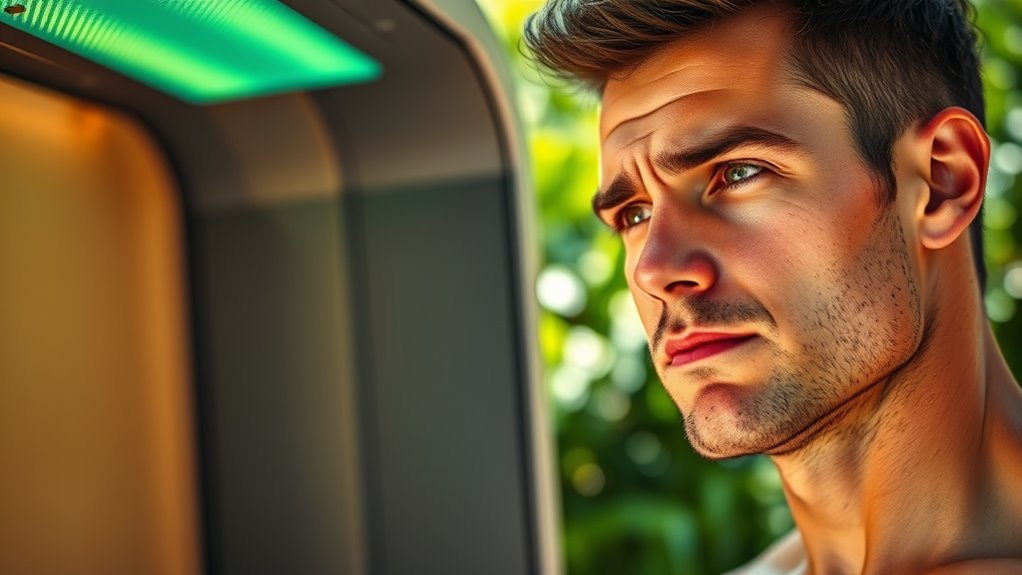
Many people worry that spray tans have an unpleasant smell, but the reality is that this odor results from a natural chemical reaction rather than poor product quality. The main culprit is dihydroxyacetone (DHA), which reacts with your skin’s amino acids, causing a pH imbalance. This chemical interaction releases a distinctive “biscuit” or “dirty sock” smell, often mistaken for body odor. It’s important to know that the scent isn’t caused by poor hygiene or spoiled products. Variations in your skin chemistry can influence how strong the odor appears, and some areas may smell more than others, especially sweaty zones like underarms. Good formulations can minimize this smell, and maintaining proper skin pH, along with post-tan care, helps keep odors at bay. Additionally, using products designed to control skin chemistry can further reduce the likelihood of unpleasant odors after tanning. Understanding chemical reactions involved in tanning can also help you choose products that produce less odor, making the experience more comfortable. Moreover, being aware of toilet flushing mechanisms and efficiency can help you manage water usage and maintain a clean bathroom environment if you’re concerned about hygiene.
Spray Tans Are Too Expensive for Men
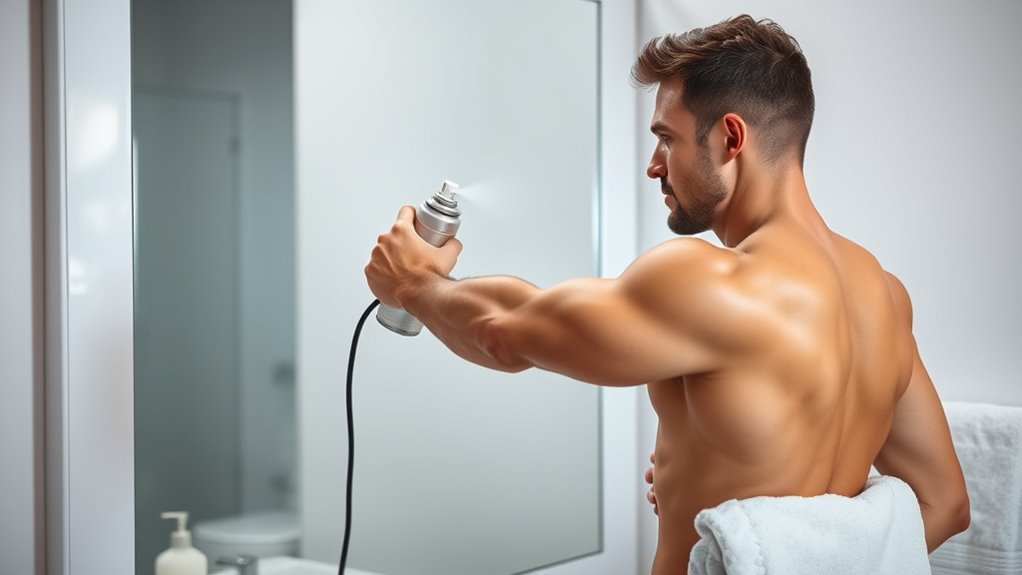
While concerns about unpleasant odors from spray tans are common, cost often tops the list of hesitations for men considering this grooming option. The average price ranges from $25 to $60 per session, making it comparable to or less than many grooming services like haircuts and facials. Prices vary depending on location, with urban and tourist-heavy areas charging more, and experienced technicians might add a premium. Specialty solutions or express tans can cost more but often deliver faster results. Considering the competitive pricing and availability of package deals, spray tans are more affordable than many believe. Since they’re temporary, you can enjoy a sun-kissed glow without a long-term financial commitment. Overall, spray tans fit comfortably within most men’s grooming budgets, making them a practical option. Additionally, Fokos offers resources and tips to help men navigate the various options for maintaining their appearance affordably.
Tanning Beds Are a Safe Alternative to Sunlight
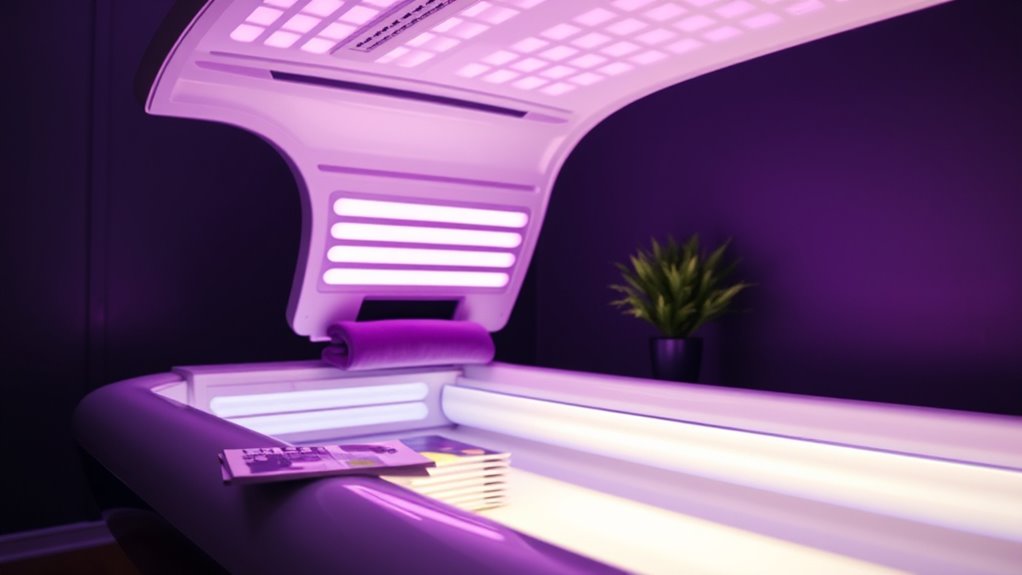
Despite the belief that tanning beds are a safer alternative to natural sunlight, they actually pose significant health risks. Tanning beds emit mostly UVA rays, which are up to 12 times more intense than natural sunlight, increasing your chances of skin damage. Some beds emit UV radiation three times stronger than the sun, allowing shorter sessions but raising safety concerns. They mainly produce UVA (about 95%) with a small amount of UVB, mimicking the sun’s spectrum but at higher intensities. This UVA radiation penetrates deeper, accelerating skin aging and damaging DNA. Importantly, the World Health Organization classifies tanning beds as carcinogens. Using them increases your risk of skin cancer, premature aging, and immune suppression—making them far from a safe alternative to sunlight.
Tanning Naturally Is Better Than Using Spray Tans

Natural tanning through sun exposure might seem like the straightforward way to achieve a sun-kissed glow, but it comes with notable health risks. UV rays increase your chances of skin damage and skin cancer, making prolonged sunbathing risky. In contrast, spray tans use DHA, a safe ingredient that doesn’t involve UV exposure, reducing your risk of long-term skin damage. Spray tanning offers quick, convenient results without the hassle of spending hours outdoors. It also allows for a more even, customizable tan that looks natural when applied correctly. Plus, you can do it at home, saving time and avoiding pollutants or harmful chemicals found in some traditional tanning methods. Overall, spray tans provide a safer, more controlled way to achieve that perfect glow without risking your health.
Frequently Asked Questions
Can Indoor Tanning Cause Long-Term Skin Damage Even Without Burning?
Indoor tanning can cause long-term skin damage even if you don’t burn. Each session leads to cumulative DNA damage, speeding up skin aging like wrinkles, sagging, and hyperpigmentation. UV exposure from tanning beds breaks down collagen and dehydrates your skin, resulting in premature aging signs. Plus, repeated damage increases your risk of skin cancers, including melanoma, basal, and squamous cell carcinoma. Even without burns, tanning harms your skin over time.
Are There Any Health Benefits Associated With Spray Tanning?
You might wonder if spray tanning offers health benefits. It does: it gives you a sun-kissed glow without UV exposure, reducing skin cancer risks and preventing premature aging. Plus, it evens out your skin tone and enhances muscle definition, boosting your confidence. Since it’s a topical application that doesn’t penetrate deep, it’s safe when used properly. Overall, spray tanning helps you look good while protecting your skin health.
How Can Men Find Affordable and Natural-Looking Spray Tan Options?
You want a tan that won’t break the bank or turn you into an orange superhero? Look for package deals or memberships at reputable salons, which offer better prices for multiple sessions. For serious savings, try high-quality self-tanning lotions that mimic the real thing without the hefty price tag. Always choose professionals who use natural DHA and avoid gimmicks—your skin and wallet will thank you.
Is There a Way to Tan Safely Without Increasing Skin Cancer Risk?
You can tan safely without increasing skin cancer risk by choosing sunless options like spray tans or tanning lotions, which avoid UV exposure altogether. Always remember to wear broad-spectrum sunscreen with at least SPF 30 when you’re outdoors, limit your sun time, and seek shade whenever possible. Staying hydrated, moisturizing your skin, and avoiding tanning beds also considerably reduce your risk, giving you a healthy glow without danger.
Do Professional Spray Tans Stain or Damage Clothing and Skin?
Imagine your clothes as a canvas, ready to catch spray tan droplets like a sponge soaking up paint. Professional spray tans can transfer to fabrics, especially light ones, but wearing dark, loose clothing minimizes staining. They won’t damage your skin if you follow proper care, and modern formulas are designed to be gentle. Just protect your clothes and skin, and you’ll enjoy your tan without worries.
Conclusion
Don’t let these myths fool you—there’s more to tanning than meets the eye. Whether you’re considering indoor tanning or spray tans, the truth might surprise you. Before you make a decision, ask yourself: what are you risking? The real story could change your perspective forever. Stay informed, stay safe, and remember—sometimes, the biggest secrets are hidden in plain sight. Are you ready to uncover what’s really behind the tan?
